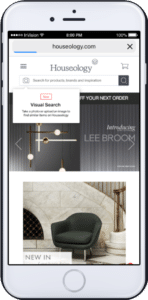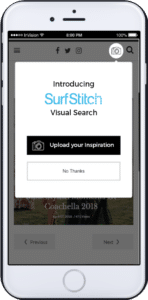Everywhere you look, new technologies are continuously transforming customer expectations and experiences, and it’s happening at a faster pace and with a wider impact. With visual search for retail, it’s no different.
“For retailers, it’s no longer going to be sufficient to innovate simply to meet an existing customer trend… Successful retailers will not be those who meekly follow the customer like some obedient puppy. They will be one step ahead, offering people new ways to make their lives that bit better,” Phillip Clarke, Tesco’s CEO, noted.
In fact, McKinsey & Company found that, 70% of customers who use apps, preferred added functionality over “look and feel,” reflecting growing expectations of superior service. Among enterprises, Forrester revealed that 80% are investing in improving customer experience in the next 12 months.
Visual search is one of the most in-demand digital solutions in retail today, delivering a better, more seamless shopping experience to customers. Using visuals such as a screenshot, real-world photo, and even icon-based filters, customers immediately and intuitively find the products they are looking for.
The obstacle of digital customer adoption
Investing in a new digital capability such as visual search is just a scratch on the surface. McKinsey & Company further shared, “a typical pitfall we observe is that many projects falter because not enough thinking goes into actively stimulating customer adoption […] Thus, orchestrating and stimulating digital customer adoption thoroughly is a key success factor.”
Adding visual search on your site or app gives you a competitive advantage, empowering customers throughout their buying journey—from product discovery to purchase. However, you first have to overcome the obstacle of digital customer adoption. Based on Syte’s clients’ experiences, you can implement these tried and tested best practices so you can get ROI from your new visual search solution.
1. Communicating the new visual search feature to the customer
With so much noise competing for your customer’s attention, it can be very difficult for them to recognize that you have a new feature on your site or app. Grab their attention by implementing one or two of these techniques:

Call-to-action email. Notify customers of the new visual search feature with a dynamic email that enables customers to click on the link and be redirected to the platform. Since on average, users only read the first line and a half of the text, make sure to keep it short and simple.
Product teaser video. Stir excitement while sharing your upcoming feature with a short teaser video. Again, keep it short and simple. According to HubSpot, videos under 90 seconds see an average retention rate of 53%, compared to only 10% for videos over 30 minutes.
Landing page. Trigger initial usage with a relevant landing page that introduces your new visual search feature. When it comes to attracting your customer’s attention with a compelling headline and landing page, you only have up to 8 seconds. After that, customers leave. Ensure that your landing page showcases the direct benefits visual search provides to your customers.
Shoutouts and pop-ups. In case your customers miss all of the announcements about your new visual search feature, you can reintroduce it to them while they’re browsing your site or app. With shoutouts and pop-ups anchored to the camera button, you can draw your customers’ attention to the new feature and encourage them to explore and eventually use visual search.

2. Educating your customers about the new feature
After introducing your new visual search feature, the next challenge is showing how it works so customers can use it to their advantage and convenience. Here are ideas to guide your customers toward full adoption of your powerful visual search tool:
Step-by-step instructions. Shorten the time it takes customers to adopt a new feature with step-by-step instructions upon landing on the home page. Help users through the new process with an interactive guide so they can easily feel comfortable using visual search.
Instructional video resource. Explain the use of the new feature with a short video that users can watch without leaving your site or app. Hit two birds with one stone as you not only educate customers but also encourage them to buy. According to HubSpot, after watching a video, 64% of users are more likely to buy a product online.
3. Making visual search relevant to your customers’ buying journey
Drive consistent engagement and usage of the new visual search feature by offering incentives that entice customers to adopt. Show customers how leveraging visual search makes their entire shopping experience better with the following instant gratification initiatives:
Coupons and cashback. Help encourage customers to use the new visual search feature with discounts. You can also motivate them to return and buy more by allowing favoriting products and building a wish list. According to Nielsen, as cited by KPMG, product discounts (51%) and cashback (45%) are the most valued customer loyalty programs.
Quick and simple product discovery. Work on your customers’ mobile usage behavior. Promote the new visual search feature by quickly showing products to customers through a like or dislike (“Tinder” style) option, enabling them to get inspired, save looks, and get similar items for looks that they swiped right for.
Dynamic recommendation product pages. Seamlessly let your customers discover new products. With the new visual search feature, your customers get a designated and customized results, which enables them to purchase the complementary, shoppable items as seen in the uploaded image.
This technology has so much potential to increase engagement and boost revenue. But before achieving these, your customers need to use it first. To drive customer adoption of your new digital capability, it is crucial to consider your present customers—their different personas and shopping habits—and choose the right mix of techniques to engage them accordingly.
After all, “for these new consumers, the value is in having accurate information in the format they prefer, in addition to buying exactly what they want, when they want it and how they want it,” Veronique Filip, Customer Advisory and Experience Leader, Deloitte South Africa, shared.